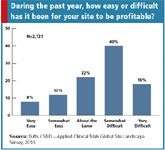Chasing Veteran US Sites Out of the Enterprise
Applied Clinical Trials
Why investigative sites are at financial risk and how it may effect sponsors and CROs.
It is a little known fact at the present time, but many investigative sites in the United States—particularly veteran sites supporting substantial clinical research infrastructure—are financially distressed and struggling. A small percentage of sites are managing to grow their revenue and profitability. However, nearly all investigative sites across academic, practice-based, and dedicated clinical research settings consider the past 24 months to be the most difficult they have ever faced.
Throughout 2009 and 2010, principal investigators and study staff have reacted to a down economy and a tumultuous operating environment in a variety of ways. Some community-based sites have opted to increase their clinical practice revenue and to pass on conducting clinical research. Academic centers have focused more attention on government grant opportunities and limited but growing funding support from patient advocacy groups. This past summer, a handful of investigative sites established Phase I research facilities hopeful that they might enter this potentially lucrative market characterized by rapid relative growth in clinical trial activity, high per patient grant amounts, and intense competition from contract research organizations (CROs). Some investigative sites have closed their doors never to return to clinical research.

Kenneth Getz
The economic plight of US investigative sites demands closer scrutiny by sponsors, CROs, and the Food and Drug Administration. This fragile community of professionals faces increasing pressure from sponsors and CROs to perform more predictably, effectively, and efficiently. At the same time, the FDA is tightening its reins, expanding oversight, and conducting more frequent inspections of investigative sites.
Unintended hardship
True, some of the recent decline in financial health of the US investigative site landscape can be attributed to the downturn in the global economy. Clinical trial activity—as measured by new clinical trials started—has declined by 40 percent since the second quarter of 2008. Numerous programs have been halted and cancelled. In many cases, investigative sites have invested substantial resources in getting trials started and under way only to learn that they have been terminated.
The tenuous condition of US investigative sites is also a direct result of sponsors' drug development practices implemented over the past decade. Protocol designs, for example, have become far more complex. Research that I have conducted with my colleagues at the Tufts Center for the Study of Drug Development (Tufts CSDD) shows unequivocally that protocols have become unwieldy and are harming clinical trial performance.
Sponsors have vied to conduct more robust early stage studies and to collect more clinical data throughout the pre- and post-approval clinical phases. The average number of procedures per protocol and the typical effort required of study staff to execute these procedures, for example, have each increased by more than 50 percent from the early to the late 2000s. The number of eligibility criteria for protocols conducted in 2007 and 2008 grew by nearly 60 percent over levels observed in the early 2000s. The average number of amendments per protocol has increased in step with the growth in design complexity. Yet grant dollars per procedure per protocol paid to investigative sites declined by 7 percent annually, when adjusted for inflation, during the decade.
The migration of FDA-regulated clinical trials overseas during the past decade—primarily into emerging markets including India, China, and Central and Eastern Europe—has been motivated in large part by economic advantages there. Sponsor companies have found a high volume of eager, treatment-naïve patients, and large numbers of well-trained professionals willing to perform at half the cost of their counterparts in the United States and Western Europe. These economic advantages have prompted sponsors to place 38 percent of their clinical trials among investigators in emerging markets in 2010. Indeed, some sponsors have set and implemented plans to recruit as much as 65 percent of their investigative sites in global regions outside the United States and Western Europe. Globalization has helped commoditize study conduct services and inspired pharmaceutical and biotechnology professionals to continue to pursue low cost investigative sites.
Facing highly-unpredictable investigative site operating performance, sponsors and CROs have pursued a practice dubbed "hedging" since the early 2000s. Clinical trials are routinely placed among a larger number of sites where each one is contracted to recruit a smaller number of patients. This approach hedges operating risk by spreading the number of patients across more individual sites. But the overall number of patients recruited per site per study is declining, making many trials economically unattractive to US-based sites—especially those with substantial infrastructure. Under the practice of hedging, sponsors and CROs have further encouraged novice investigators, those with little to no experience and infrastructure, to enter the fray as they can accept unattractive grant amounts more easily, often a result of their naïveté.

During the past year, how easy or difficult has it been for your site to be profitable?
Financially distressed
Sponsor and CRO grant management practices are particularly at fault for facilitating a more fragile community of investigative sites. In a study jointly conducted by Applied Clinical Trials and Tufts CSDD this year, 60 percent of nearly 3,000 global investigative sites reported that the past 12 months has been difficult to maintain profitability. Sites face major cash flow challenges: In a study conducted two years ago, we found that it takes on average nearly 120 days for sites to receive payments from sponsors and CROs for work already performed. Most sites operate on a cash basis where their expenses are paid net 45 days.
Sponsor payment schedules favor allocating large portions of the grant to the end of the study, with funds held back until the data has been locked (e.g., after all sites have completed enrollment and the clinical data has been cleaned).
Research conducted by, and presented at, the Site Solutions Summit this past October depicts a particularly shaky and alarming period for US-based investigative sites:
- Fifteen percent of annual site revenue is older than 90 days.
- One-third of sites are writing off aged accounts receivables. This is up from only 15 percent who wrote off uncollected receivables in the prior year.
- Dedicated, experienced investigative sites have been forced to borrow money in order to survive. On average, each site is carrying a debt-load of almost $400,000.
A wake up call
Natural market forces across the global economy are based on products and services that offer superior value. Within the clinical research enterprise, it is a rational behavior for sponsors and CROs to seek lower cost for faster study conduct.
But in the current operating environment, sponsors and CROs are arguably driving the most experienced US-based investigative sites out of the clinical research enterprise at a time when they are needed most. Forces alienating these investigative sites are not purely market based, but rather they are due to short-sighted drug development practices that are unintentionally preventing collaborations that hold the greatest promise in delivering higher performance and efficiency in the long run.
The most experienced US-based investigative sites play an integral role in delivering a high level of professionalism, integrity, and expertise. They are a most vital link to study volunteers in the United States, offering patients quality care and essential access to investigational treatments. Veteran investigative sites and those with established clinical research infrastructure hold unprecedented promise in forging progressive relationships with sponsors and CROs that integrate communications, study management processes, and clinical and health information technology systems.
Some companies and organizations (e.g., CTTI) are already looking at this growing problem. But much more needs to be done and quickly. As a start, each sponsor and CRO must open a dialogue with its experienced US-based investigative sites. This dialogue must include a review of practices contributing to the onerous regulatory compliance burden placed on clinical investigators; of the rising complexity of study protocols and how to simplify and streamline designs in order to improve study conduct feasibility; and of the fragile financial health of many investigative sites and the grant management practices contributing to this dangerous condition. Ultimately, this dialogue will assist in prompting sponsors and CROs to identify concrete ways to change their drug development practices in order to support the success of their US investigative sites... not their demise.
Kenneth A. Getz MBA, is a Senior Research Fellow at the Tufts CSDD and Chairman of CISCRP, both in Boston, MA, email: kenneth.getz@tufts.edu

Improving Relationships and Diversifying the Site Selection Process
April 17th 2025In this episode of the Applied Clinical Trials Podcast, Liz Beatty, co-founder and chief strategy officer, Inato, discusses a number of topics around site engagement including community-based sites, the role of technology in improving site/sponsor relationships, how increased operational costs are impacting the industry, and more.